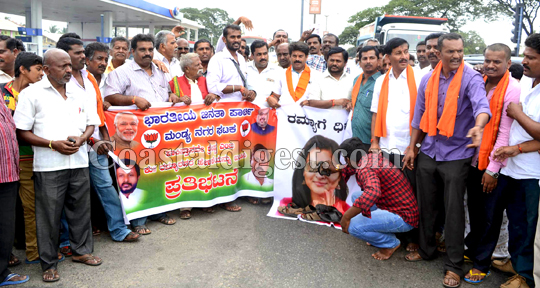Mandya, Aug 22: BJP workers in Mandya protested against film star-turned-politician after she rebutted Union Defence Minister Manohar Parrikar's comment that “going to Pakistan is like going to hell”.

Ms. Ramya, who visited Pakistan to attend SAARC conference recently, said the ground-level situation in the country was different.
Reacting to her comments, former BJP State president Pralhad Joshi asked her to go to Pakistan, and BJP leader Jaggesh said she was issuing such statements to appease her party's national leadership.
The former Mandya MP is also being trolled on social media for the last three days following her comment.
Participating in an ABVP protest against anti-nationalism, Jaggesh said: "People who have not studied and don't have any experience are praising Pakistan. They should be given a peace prize, maybe a Nobel. They should also be allowed to stand next to Bill Clinton and take photos."
Not stopping there, Jaggesh described those supporting anti-national sentiments as 'mosquiotoes and bedbugs', and that they should be destroyed with poison. Ramya reacted with a tweet that read: "Ouch! That hurts!"
She also sarcastically tweeted a report about RSS chief Mohan Bhagwat saying Pak is our brother' government must work to improve ties'. Her tweet said: “Mohan Bhagwatji of the RSS says that Pakistan is India's brother :) & @narendramodi famous visit to pak we all know (sic).”
Ramya supporters react
Meanwhile, Ramya's supporters on social media have questioned the double standard of BJP, which remained silent when Art of Living founder Sri Sri Ravi Shankar raised Pakistan Zindabad slogan.
“Ramya never raised Pakistan Zindabad slogan like pro-BJP guruji. She just said that all Pakistanis are not bad,” they said, reminding Prime Minister Narendra Modi's Islamabad visit without invitation.
“Last year RSS said Pakistan is “our brother”. Before that L K Advani praised Pakistan founder Jinnah. Several BJP leaders praised Pakistan on different occasions. But when a true Indian like Ramya gives a statement, they ask her to go to Pakistan,” said one of her follower.






Comments
Wa wa Fantastic You Criminal Looters RSS, your criminal leaders went there now telling very bad lies our great leader Ramya Banu!!!! Bap Ray Bap no good Criminaljees, you never become Nationalist of Hindustan. Gangasara bai Naren where are you man what your sister says, Still you in Snake Land (Thailand) or Gangasara land do not hide bhai come forward your Criminal Looters are in danger situation.
Baloochistan people are good as Modi and Bhakts accepted. When Ramya said something, bakts got angry.
Mutalik hoist Pakistan flag at Indian soil, bhakts get quiet, bhakts on street on rumor for azadi slogan at amnesty program.
Terror attacking Muslim cow trader, bhakts happy and they gone quiet when Praveen poojary got killed by same terror..
Bhakts happy for beef exporting and opposing beef consuming in India.
@rikaz u feel proud of women's medal earned in rio, in the same way u dont support the girls for sports. what i should call this women's downfall? :)
India got one silver medal and a bronze.....Women's power....BJP don't realize that.....
akkavre nimge edu beka, sumne picturalli dance madi mai kai torisidre hana baruthe bidi .
Ramya just wanted the publicity for next election, idea given by congo high command.
Good one Ramya mam. proud of you
nothing wrong in ramya's statement but have ever even one pak politician said the same to india!! because they washed out hindus from their country and they dont need them, in a opposite statement it will benefit ramya.
Rahul ji sambalo apki ramya ko, kya kya bakh rahi he,
Add new comment